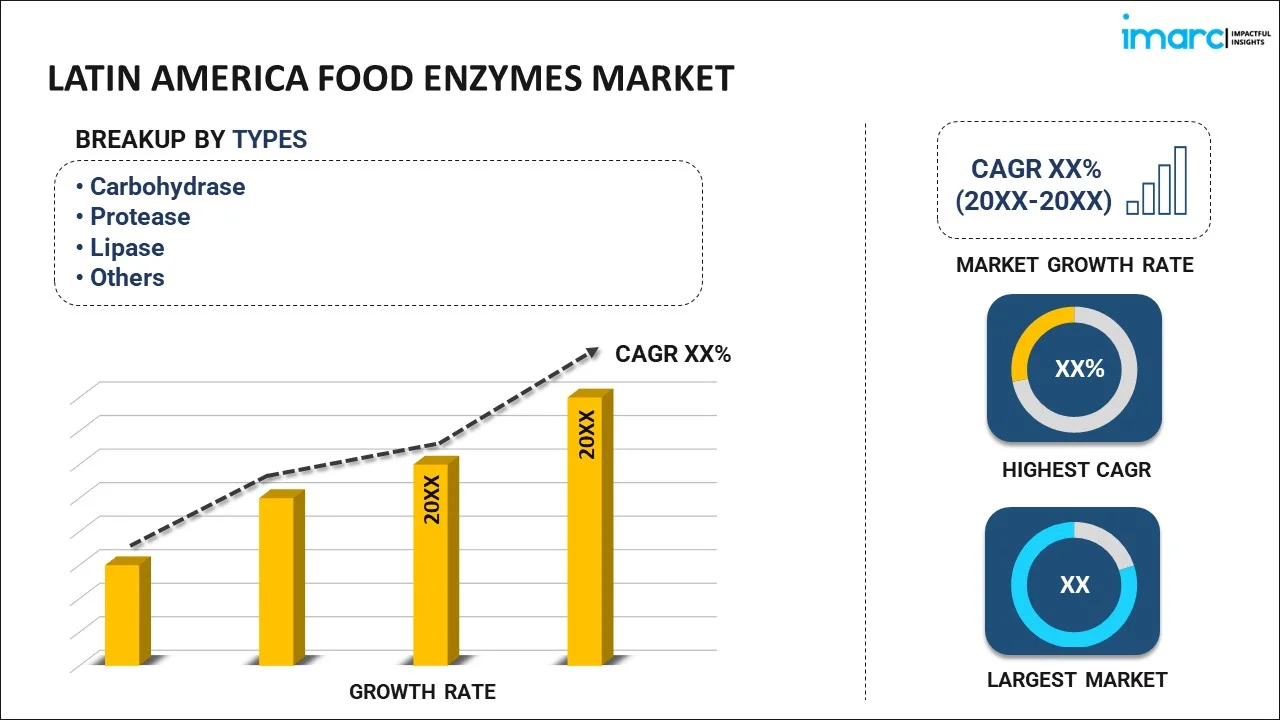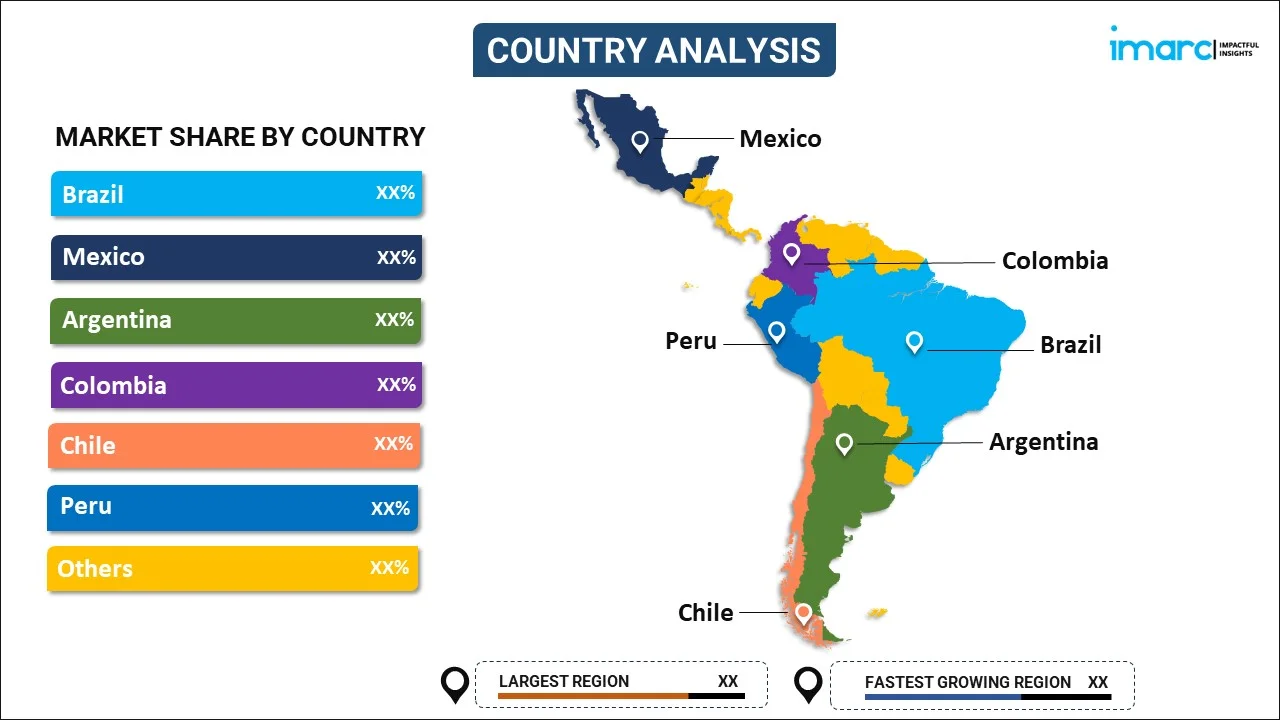
Latin America Food Enzymes Market Report by Type (Carbohydrase, Protease, Lipase, and Others), Source (Microorganisms, Bacteria, Fungi, Plants, Animals), Formulation (Powder, Liquid, and Others), Application (Beverages, Processed Foods, Dairy Products, Bakery Products, Confectionery Products, and Others), and Country 2025-2033
Market Overview:
The Latin America food enzymes market size reached USD 205.8 Million in 2024. Looking forward, IMARC Group expects the market to reach USD 293.4 Million by 2033, exhibiting a growth rate (CAGR) of 3.82% during 2025-2033.
|
Report Attribute
|
Key Statistics
|
|---|---|
|
Base Year
|
2024
|
|
Forecast Years
|
2025-2033
|
|
Historical Years
|
2019-2024
|
|
Market Size in 2024
|
USD 205.8 Million |
|
Market Forecast in 2033
|
USD 293.4 Million |
| Market Growth Rate 2025-2033 | 3.82% |
Food enzymes are additives that assist in the breaking down of indigestible nutrients into easily digestible forms. Enzymes, such as proteases, lipases, and carbohydrase, are widely used in the production of various beverages and bakery and confectionary products, thus forming a quintessential part of the food and beverage industry. The utilization of food enzymes in edible products not only adds flavor but also aids in increasing their shelf-life while maintaining their nutritional content.
The presence of a well-established food and beverage industry is one of the primary factors driving the market for food enzymes in the Latin American region. In line with this, the enzymes find extensive application in various bakery products for stabilizing the dough and facilitating the fermentation of bread. Moreover, the rising demand for packaged and ready-to-eat food items, due to hectic lifestyles led by a steadily increasing working population, is contributing to the market growth. Food enzymes are widely utilized in these products to increase their shelf-life without compromising on the nutritional quotient. Other factors, such as the significant growth in the food processing industry and improving infrastructural facilities, including transportation, and increasing investments in the establishment of technologically advanced cold chain facilities, are driving the market further in the region.
Key Market Segmentation:
IMARC Group provides an analysis of the key trends in each segment of the Latin America food enzymes market report, along with forecasts at the regional and country levels from 2025-2033. Our report has categorized the market based on type, source, formulation and application.
Breakup by Type:

- Carbohydrase
- Amylase
- Cellulase
- Lactase
- Pectinase
- Others
- Protease
- Lipase
- Others
Breakup by Source:
- Microorganisms
- Bacteria
- Fungi
- Plants
- Animals
Breakup by Formulation:
- Powder
- Liquid
- Others
Breakup by Application:
- Beverages
- Processed Foods
- Dairy Products
- Bakery Products
- Confectionery Products
- Others
Breakup by Country:

- Brazil
- Mexico
- Argentina
- Colombia
- Chile
- Peru
- Others
Competitive Landscape:
The competitive landscape of the industry has also been examined along with the profiles of the key players.
Report Coverage:
| Report Features | Details |
|---|---|
| Base Year of the Analysis | 2024 |
| Historical Period | 2019-2024 |
| Forecast Period | 2025-2033 |
| Units | Million USD |
| Segment Coverage | Type, Source, Formulation, Application, Country |
| Countries Covered | Argentina, Brazil, Mexico, Colombia, Chile, Peru, Others |
| Customization Scope | 10% Free Customization |
| Post-Sale Analyst Support | 10-12 Weeks |
| Delivery Format | PDF and Excel through Email (We can also provide the editable version of the report in PPT/Word format on special request) |
Key Questions Answered in This Report:
- How has the Latin America food enzymes market performed so far and how will it perform in the coming years?
- What has been the impact of COVID-19 on the Latin America food enzymes market?
- What are the key regional markets?
- What is the breakup of the market based on the type?
- What is the breakup of the market based on the source?
- What is the breakup of the market based on the formulation?
- What is the breakup of the market based on the application?
- What are the various stages in the value chain of the industry?
- What are the key driving factors and challenges in the industry?
- What is the structure of the Latin America food enzymes market and who are the key players?
- What is the degree of competition in the industry?
Need more help?
- Speak to our experienced analysts for insights on the current market scenarios.
- Include additional segments and countries to customize the report as per your requirement.
- Gain an unparalleled competitive advantage in your domain by understanding how to utilize the report and positively impacting your operations and revenue.
- For further assistance, please connect with our analysts.

 Inquire Before Buying
Inquire Before Buying
 Speak to an Analyst
Speak to an Analyst
 Request Brochure
Request Brochure
 Request Customization
Request Customization



.webp)




.webp)












